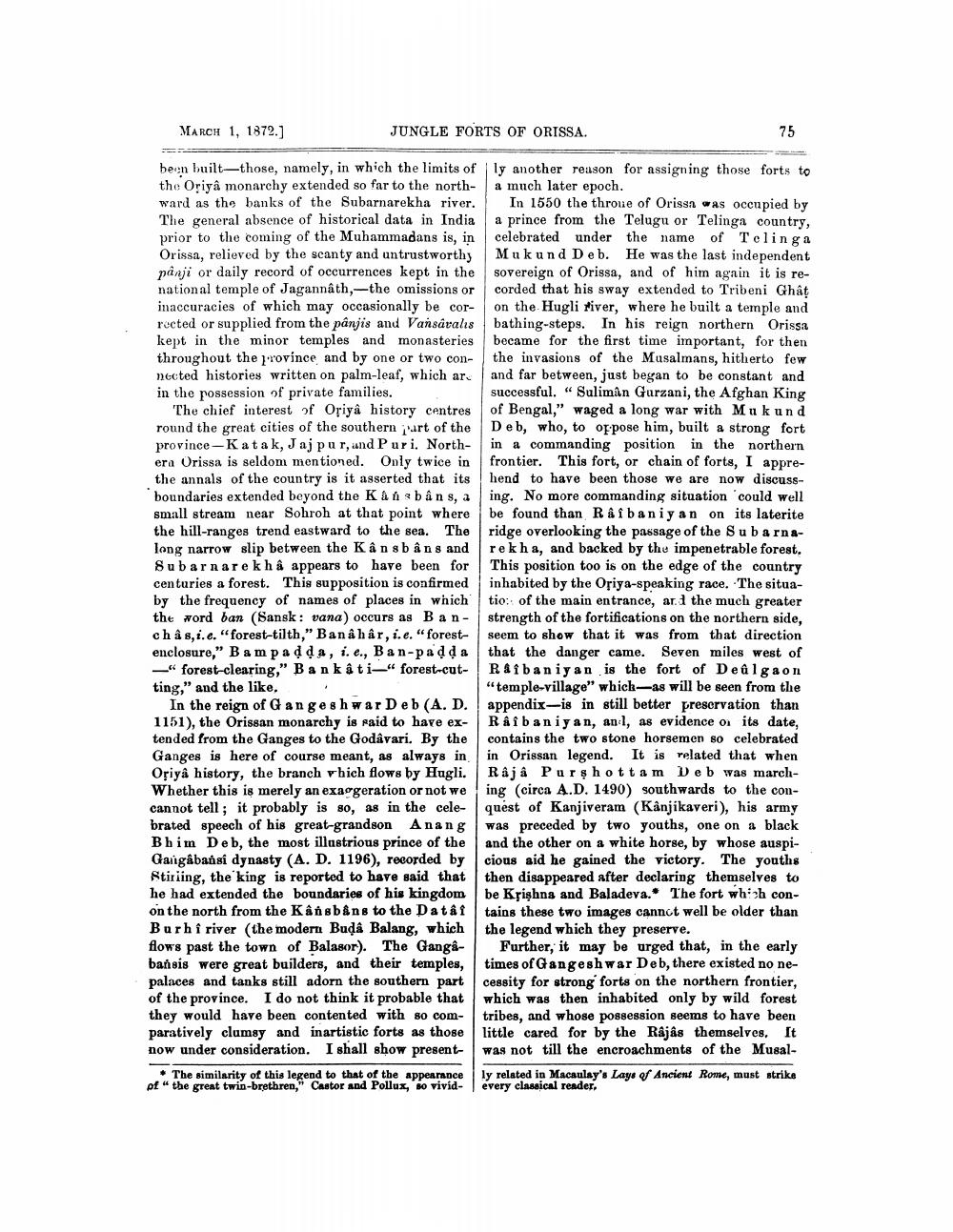________________
MARCH 1, 1872.]
JUNGLE FORTS OF ORISSA.
been built-those, namely, in which the limits of ly another reason for assigning those forts to the Oriyâ monarchy extended so far to the north- a much later epoch. ward as the banks of the Subarnarekha river. In 1550 the throue of Orissa was occupied by The general absence of historical data in India a prince from the Telugu or Telinga country, prior to the coming of the Muhammadans is, in celebrated under the name of Telinga Orissa, relieved by the scanty and untrustworthy Mukund Deb. He was the last independent pânji or daily record of occurrences kept in the sovereign of Orissa, and of him again it is renational temple of Jagannath,—the omissions or corded that his sway extended to Tribeni Ghât inaccuracies of which may occasionally be cor- on the Hugli river, where he built a temple and rected or supplied from the panjis and Vansaralıs bathing-steps. In his reign northern Orissa kept in the minor temples and monasteries became for the first time important, for then throughout the province and by one or two con- the invasions of the Musalmans, hitherto few nected histories written on palm-leaf, which ar and far between, just began to be constant and in the possession of private families.
successful. “Suliman Gurzani, the Afghan King The chief interest of Oriya history centres of Bengal," waged a long war with Mukund round the great cities of the southern art of the Deb, who, to of:pose him, built a strong fort province -Katak, Jajpur,und Puri. North- in a commanding position in the northern era Orissa is seldom mentioned. Only twice in frontier. This fort, or chain of forts, I apprethe annals of the country is it asserted that its hend to have been those we are now discussboundaries extended beyond the Kan bån
s ing. No more commanding situation could well small stream near Sohroh at that point where be found than Rai baniyan on its laterite the hill-ranges trend eastward to the sea. The ridge overlooking the passage of the Subarnalong narrow slip between the Kânsbån 8 and rekha, and backed by the impenetrable forest. Subarnarekh â appears to have been for This position too is on the edge of the country centuries a forest. This supposition is confirmed inhabited by the Oriya-speaking race. The situaby the frequency of names of places in which tio: of the main entrance, ard the much greater the word ban (Sansk: vana) occurs as Ban- strength of the fortifications on the northern side, ch â s, i.e. "forest-tilth," Bana hâr, i.e." forest- seem to show that it was from that direction enclosure," Bampadda, i.e., Ban-padda that the danger came. Seven miles west of _“forest-clearing," Bankâti-“forest-cut- Raiban iyan is the fort of Deûlgaon ting," and the like.
"temple-village" whick—as will be seen from the In the reign of Gangeshwar Deb (A. D. appendix-is in still better preservation than 1151), the Orissan monarchy is paid to have ex- R á í baniyan, an I, as evidence on its date, tended from the Ganges to the Godavari. By the contains the two stone horsemen so celebrated Ganges is here of course meant, as always in in Orissan legend. It is related that when Oriya history, the branch which flows by Hugli. Raja Purshottam Deb was marchWhether this is merely an exaggeration or not we ing (circa A.D. 1490) southwards to the concannot tell; it probably is so, as in the cele- quest of Kanjiveram (Kanjikaveri), his army brated speech of his great-grandson Anang was preceded by two youths, one on a black Bhim Deb, the most illustrious prince of the and the other on a white horse, by whose auspiGarigabansi dynasty (A. D. 1196), recorded by cious aid he gained the victory. The youths Stiriing, the king is reported to have said that then disappeared after declaring themselves to he had extended the boundaries of his kingdom be Krishna and Baladeva.* The fort which conon the north from the Kansbåns to the Datât tains these two images cannot well be older than Burh î river (the modern Buļa Balang, which the legend which they preserve. flows past the town of Balasor). The Ganga- Further, it may be urged that, in the early bansis were great builders, and their temples, times of Gangeshwar Deb, there existed no nepalaces and tanks still adorn the southern part cessity for strong forts on the northern frontier, of the province. I do not think it probable that which was then inhabited only by wild forest they would have been contented with so com- tribes, and whose possession seems to have been paratively clumsy and inartistic forts as those little cared for by the Rajâs themselves. It now under consideration. I shall show present- was not till the encroachments of the Musal
The similarity of this legend to that of the appearancely related in Macaulay's Lays of Ancient Rome, must strike of "the great twin-brethren," Castor and Pollux, Bo vivid- every classical reader,




